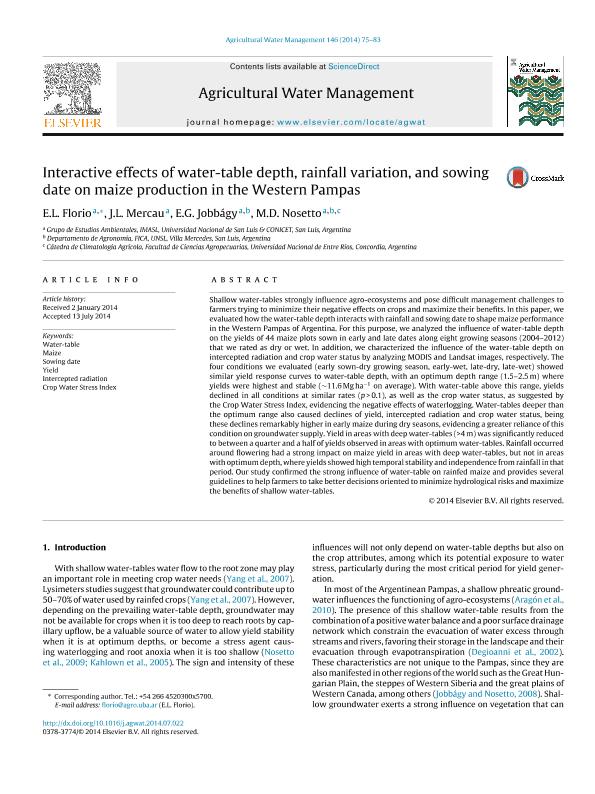Mostrar el registro sencillo del ítem
dc.contributor.author
Florio, Eva Laura

dc.contributor.author
Mercau, Jorge Luis

dc.contributor.author
Jobbagy Gampel, Esteban Gabriel

dc.contributor.author
Nosetto, Marcelo Daniel

dc.date.available
2020-09-23T14:35:18Z
dc.date.issued
2014-12
dc.identifier.citation
Florio, Eva Laura; Mercau, Jorge Luis; Jobbagy Gampel, Esteban Gabriel; Nosetto, Marcelo Daniel; Interactive effects of water-table depth, rainfall variation, and sowing date on maize production in the Western Pampas; Elsevier Science; Agricultural Water Management; 146; 12-2014; 75-83
dc.identifier.issn
0378-3774
dc.identifier.uri
http://hdl.handle.net/11336/114616
dc.description.abstract
Shallow water-tables strongly influence agro-ecosystems and pose difficult management challenges to farmers trying to minimize their negative effects on crops and maximize their benefits. In this paper, we evaluated how the water-table depth interacts with rainfall and sowing date to shape maize performance in the Western Pampas of Argentina. For this purpose, we analyzed the influence of water-table depth on the yields of 44 maize plots sown in early and late dates along eight growing seasons (2004-2012)that we rated as dry or wet. In addition, we characterized the influence of the water-table depth on intercepted radiation and crop water status by analyzing MODIS and Landsat images, respectively. The four conditions we evaluated (early sown-dry growing season, early-wet, late-dry, late-wet) showed similar yield response curves to water-table depth, with an optimum depth range (1.5-2.5 m) where yields were highest and stable (∼11.6 Mg ha−1on average). With water-table above this range, yields declined in all conditions at similar rates (p > 0.1), as well as the crop water status, as suggested by the Crop Water Stress Index, evidencing the negative effects of waterlogging. Water-tables deeper than the optimum range also caused declines of yield, intercepted radiation and crop water status, being these declines remarkably higher in early maize during dry seasons, evidencing a greater reliance of this condition on groundwater supply. Yield in areas with deep water-tables (>4 m) was significantly reduced to between a quarter and a half of yields observed in areas with optimum water-tables. Rainfall occurred around flowering had a strong impact on maize yield in areas with deep water-tables, but not in areas with optimum depth, where yields showed high temporal stability and independence from rainfall in that period. Our study confirmed the strong influence of water-table on rainfed maize and provides several guidelines to help farmers to take better decisions oriented to minimize hydrological risks and maximize the benefits of shallow water-tables.
dc.format
application/pdf
dc.language.iso
eng
dc.publisher
Elsevier Science

dc.rights
info:eu-repo/semantics/openAccess
dc.rights.uri
https://creativecommons.org/licenses/by-nc-sa/2.5/ar/
dc.subject
CROP WATER STRESS INDEX
dc.subject
INTERCEPTED RADIATION
dc.subject
MAIZE
dc.subject
SOWING DATE
dc.subject
WATER-TABLE
dc.subject
YIELD
dc.subject.classification
Agricultura

dc.subject.classification
Agricultura, Silvicultura y Pesca

dc.subject.classification
CIENCIAS AGRÍCOLAS

dc.title
Interactive effects of water-table depth, rainfall variation, and sowing date on maize production in the Western Pampas
dc.type
info:eu-repo/semantics/article
dc.type
info:ar-repo/semantics/artículo
dc.type
info:eu-repo/semantics/publishedVersion
dc.date.updated
2020-09-01T19:11:01Z
dc.journal.volume
146
dc.journal.pagination
75-83
dc.journal.pais
Países Bajos

dc.journal.ciudad
Amsterdam
dc.description.fil
Fil: Florio, Eva Laura. Consejo Nacional de Investigaciones Científicas y Técnicas. Centro Científico Tecnológico Conicet - San Luis. Instituto de Matemática Aplicada de San Luis "Prof. Ezio Marchi". Universidad Nacional de San Luis. Facultad de Ciencias Físico, Matemáticas y Naturales. Instituto de Matemática Aplicada de San Luis "Prof. Ezio Marchi"; Argentina
dc.description.fil
Fil: Mercau, Jorge Luis. Consejo Nacional de Investigaciones Científicas y Técnicas. Centro Científico Tecnológico Conicet - San Luis. Instituto de Matemática Aplicada de San Luis "Prof. Ezio Marchi". Universidad Nacional de San Luis. Facultad de Ciencias Físico, Matemáticas y Naturales. Instituto de Matemática Aplicada de San Luis "Prof. Ezio Marchi"; Argentina
dc.description.fil
Fil: Jobbagy Gampel, Esteban Gabriel. Consejo Nacional de Investigaciones Científicas y Técnicas. Centro Científico Tecnológico Conicet - San Luis. Instituto de Matemática Aplicada de San Luis "Prof. Ezio Marchi". Universidad Nacional de San Luis. Facultad de Ciencias Físico, Matemáticas y Naturales. Instituto de Matemática Aplicada de San Luis "Prof. Ezio Marchi"; Argentina
dc.description.fil
Fil: Nosetto, Marcelo Daniel. Consejo Nacional de Investigaciones Científicas y Técnicas. Centro Científico Tecnológico Conicet - San Luis. Instituto de Matemática Aplicada de San Luis "Prof. Ezio Marchi". Universidad Nacional de San Luis. Facultad de Ciencias Físico, Matemáticas y Naturales. Instituto de Matemática Aplicada de San Luis "Prof. Ezio Marchi"; Argentina. Universidad Nacional de Entre Ríos; Argentina
dc.journal.title
Agricultural Water Management

dc.relation.alternativeid
info:eu-repo/semantics/altIdentifier/doi/http://dx.doi.org/10.1016/j.agwat.2014.07.022
dc.relation.alternativeid
info:eu-repo/semantics/altIdentifier/url/https://www.sciencedirect.com/science/article/abs/pii/S0378377414002212?via%3Dihub
Archivos asociados
